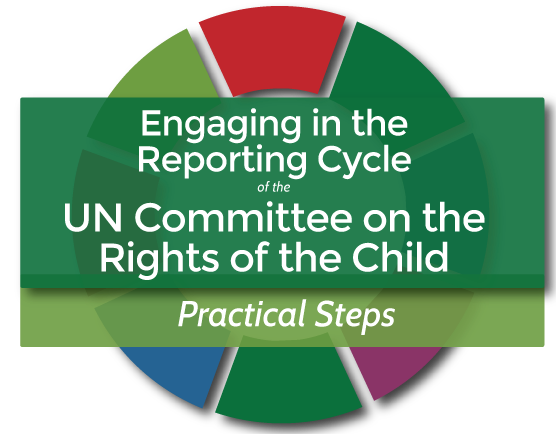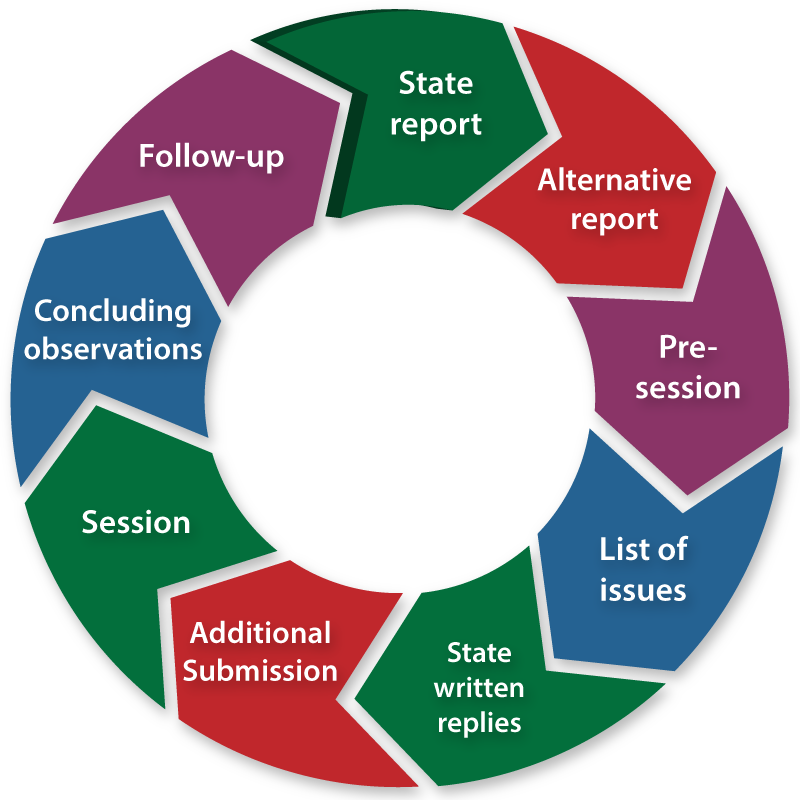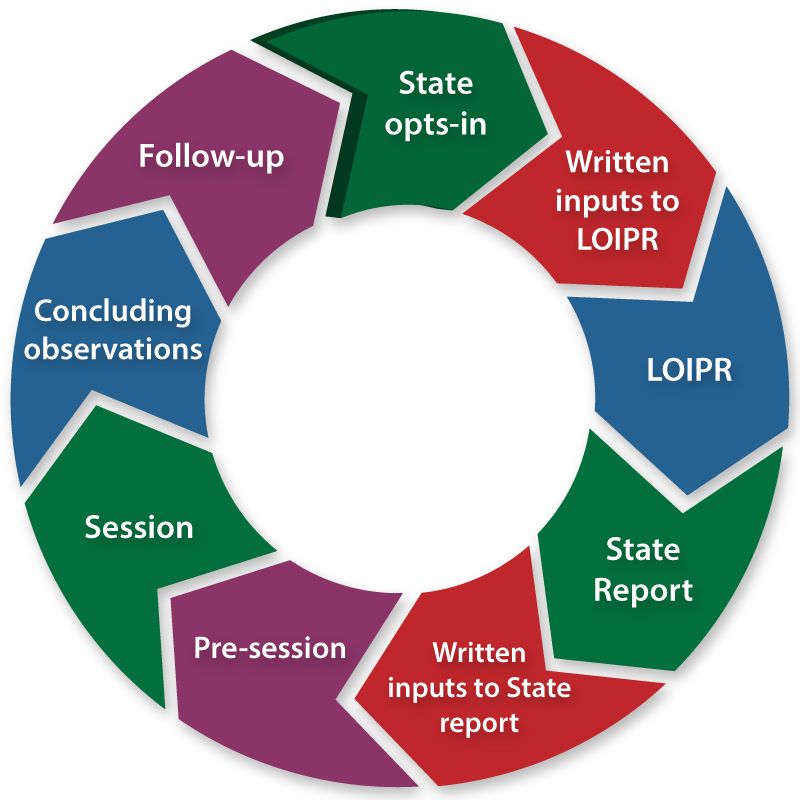Engaging in the Reporting Cycle of the UN Committee on the Rights of the Child

“National actors, such as national human rights institutions (NHRIs) and civil society organizations play an integral role in the cyclical engagement with the treaty body reporting process, through providing information, creating awareness and follow-up on the implementation of recommendations.”
Navi Pillay, UN High Commissioner for Human Rights (2012)
The Committee on the Rights of the Child (the Committee) is the body set up by the United Nations (UN) to monitor the progress that States make in fulfilling their obligations with regards to children’s human rights. These obligations are defined in the UN Convention on the Rights of the Child (CRC) and two of its Optional Protocols – the Optional Protocol on children in armed conflict (OPAC) and the Optional Protocol on the sale of children, child prostitution and child pornography (OPSC).
The Committee monitors this progress through a reporting cycle. During each cycle, States submit written information to the Committee on children’s rights in their countries. This information is included in the “State report”. The Committee reviews these reports, as well as additional information it receives, discusses the information with the national government during a meeting called “Session”, and makes recommendations or “Concluding observations” to help States improve the situation of children’s rights.
Children’s rights defenders, like children, NGOs, national human rights institutions and children’s ombudspersons, have an important role to play in this cycle. For example, they can:
- Provide comments on the State report or additional information about issues that it does not address;
- Help the Committee identify issues to ask the national government about during the review;
- Support the government in following-up to the recommendations of the Committee;
- Provide information to the Committee on how its recommendations are being implemented by the government.
Practical Steps to Engage in the Reporting Cycle
The reporting cycle is on-going. This means that you can start your engagement at any step of the process, even if you were not involved in the previous step. Once you engage, however, we encourage you to do so in the mid to long-term, and ideally at least until the next cycle starts, to ensure maximum impact. Each cycle lasts approximately 5 years.
The steps of the cycle change based on the methodology used: the Traditional Reporting Procedure or the Simplified Reporting Procedure. Check the comparative table of Traditional and Simplified Reporting Cycles, as well as the deadlines for submissions and word limits under both cycles.
Click on cycles to see what you can do.
Traditional Reporting Procedure
Click to open.
Simplified Reporting Procedure
Click to open.
About the Convention on the Rights of the Child
The Convention on the Rights of the Child defines the universal basic rights of all persons under 18 years old and what States and adults should do to make sure children enjoy these rights.
When a State ratifies the CRC, it commits to promote, protect, respect and fulfil the rights of all children under its jurisdiction – i.e. who live in a territory controlled by this State. It becomes a State party to the CRC with the responsibility to implement the rights guaranteed in the CRC at national level and to report periodically on such implementation to the UN Committee on the Rights of the Child.
Key Facts and features of the CRC
- Adopted by the UN General Assembly on 2 September 1990.
- Is the most widely-ratified – i.e. accepted – international human rights treaty with 197 States parties.
- Covers civil, political, economic, social and cultural rights.
- Created the UN Committee on the Rights of the Child to monitor how States parties implement its provisions.
About the Optional Protocols to the CRC
The CRC has 3 Optional Protocols, which expand upon the obligations set out in the CRC or the competences of the UN Committee on the Rights of the Child:
- The Optional Protocol on the Sale of Children, Child Prostitution and Child Pornography (OPSC).
- The Optional Protocol on the Involvement of Children in Armed Conflict (OPAC).
- The Optional Protocol on a Communications Procedure (OPIC).
Each of these Optional Protocols are separate legal instruments which must be ratified independently of the CRC and are only applicable to States that have ratified them.
The Optional Protocol on the sale of children, child prostitution and child pornography (OPSC)
The Optional Protocol on the sale of children, child prostitution and child pornography (OPSC) further clarifies the scope and meaning of articles 34 and 35 of the CRC and how States should deal with these crimes and support the victims.
It requires States Parties to submit a specific comprehensive report (also called “initial report”) to the UN Committee on the Rights of the Child on their implementation of OPAC provisions two years after their ratification of OPAC. Once this initial report is reviewed by the Committee, information about the implementation of OPAC provisions should be integrated into any report the State submits to the Committee under the CRC “integrated report”.
CHECK IF YOUR STATE HAS RATIFIED OPSC→
The Optional Protocol on the involvement of children in armed conflicts (OPAC) strengthens article 38 of the CRC by raising the minimum age of direct participation of children in hostilities from 15 to 18 years old and forbidding the compulsory recruitment of children into State armed forces.
It requires State Parties to submit a specific comprehensive report (also called “initial report”) to the UN Committee on the Rights of the Child on their implementation of OPAC provisions two years after their ratification of OPAC. Once this initial report is reviewed by the Committee, information about the implementation of OPAC provisions should be integrated into all reports the State submits to the Committee under the CRC as an “integrated report”.
The Optional Protocol on a communications procedure provides new competencies to the UN Committee on the Rights of the Child, such as the possibility to receive and examine individual complaints alleging violation of rights covered by the CRC and/or the OPSC and/or the OPAC, or inquire about grave or systematic violations of children’s rights.
It does not create additional reporting obligations for the State party.
The Role of Children’s Rights Defenders in the CRC
Article 45 of the CRC gives children’s rights defenders a particular role in monitoring its implementation, including the right to participate in the reporting process. This role has also been extended to the CRC’s Optional Protocols.
It is extremely important for the Committee to receive specific, reliable and objective information from children’s rights defenders in order to make a comprehensive and independent assessment of the progress made and difficulties encountered in the implementation of the CRC and its Optional Protocols.

